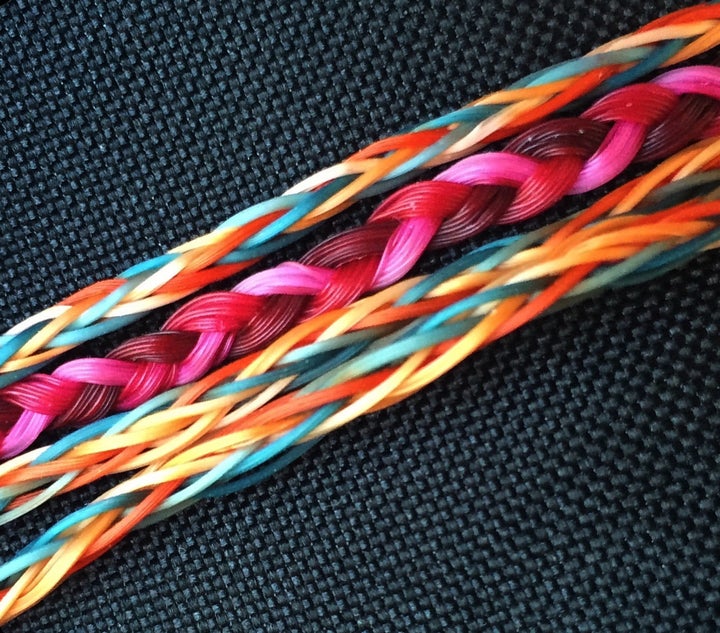Every year, millions of tons of plastics end up in the ocean. These items break down into tiny pieces called microplastics, which enter the food chain and wind up in everything from bottled water to human poop.
Lawmakers around the world are passing bans on single-use items like shopping bags and straws in an attempt to limit the flow of trash into marine ecosystems. But there’s a huge ocean plastics problem that most legislators have ignored, or don’t even know about.
The problem is our clothing.
Garments are often made from synthetic polymers, such as nylon, rayon or spandex. You like cozy fleece jackets? Many contain the same ingredient that’s in plastic bottles: polyethylene terephthalate (PET). Check the tag of the shirt you’re wearing right now. It probably contains some kind of synthetic fabric ― the majority of clothing does.
And these materials shed like crazy.
To be fair, cotton clothes and natural fabrics shed, too. All clothes do. Every time a garment is washed, tiny fibers slough off. By one estimate, a 12-pound load of acrylic-fabric laundry could release 700,000 plastic microfibers. While many natural fibers biodegrade, synthetics don’t (though natural fibers that have been chemically modified during manufacturing won’t break down in nature, either).
Microfibers “are the most common type of microplastics found in the oceans and in the environment,” says Nicholas Mallos of Ocean Conservancy, an environmental nonprofit.

It’s not just clothing that’s a problem. Plastic microfibers, which measure less than 5 millimeters in size, can come from many sources ― carpets, furniture, fishing nets or even cigarette butts. But the most well-documented source is clothing. Without proper management, microfibers from washing machines enter waste effluent, escape wastewater treatment plants and reach the ocean.
While it’s not clear precisely how much of the microfibers in the ocean come from laundry versus other pathways, there are steps that people can take to try to curb the number of microfibers they release into the environment, Mallos adds.
“We know enough to be concerned and we know enough to take action, particularly on the source that originates from washing machines,” he says.
Lawmakers in New York and California have proposed bills requiring clothes containing more than 50% synthetic materials to carry a tag that reads, “This garment sheds plastic microfibers when washed.” But their efforts don’t have broad support from the textile industry. Even politicians aren’t convinced the measures will be effective.
“It probably won’t change too many adults’ minds,” according to Felix Ortiz, the assistant speaker of the New York state Assembly who introduced the bill in New York, per The Wall Street Journal.
In the meantime, a washing machine lint trap seems like an obvious solution. While dryers tend to come with traps pre-installed, your washer probably doesn’t have one, unless you live in Japan, says Mallos. In a preliminary study, he and colleagues from the University of Toronto found that a filter stopped an average of 87% of microfibers leaking out from the washer. If you’re handy, you can install a filter on the back end of your washer to capture microfibers. Moving forward, says Mallos, filters should become a regular part of new washers.
There are also products you can drop into the washer that collect or trap microfibers as they shed off clothes, such as the Guppyfriend bag or the Cora Ball. At the end of each washer cycle, you can clean off the lint and throw it in the trash.
These are easy, short-term fixes, but they don’t guarantee proper disposal of the trapped microfibers, meaning they could end up in the environment anyway. What’s more, these fixes don’t stop clothes from shedding in the first place.
“Extra effort shouldn’t be on the consumer, it should be on manufacturers,” marine environment expert Heidi Savelli said in a piece published on the United Nations Environment blog earlier this year.
Clothing brands and textile companies are paying attention to the problem of microfiber shedding, says Elissa Foster of outdoor apparel company Patagonia.
“The big role that brands and textile manufacturers have in this issue is looking at fabric construction to find ways to minimize shedding,” says Foster.
The first step, she notes, is creating a standard fabric shed test for manufacturers to quantify and compare how much each type of fabric sheds and what makes them shed.
The American Association of Textile Chemists and Colorists is now convening industry experts from various brands and producers to come up with such a standardized test method. Once established, manufacturers can study and explore options that might decrease shedding, such as the types of yarn, types of twist in the yarn and additional finishing steps like brushing or tumbling, says Foster.
Another solution is to create synthetic fibers that can actually break down if they escape into the environment ― especially those that don’t pass through a wastewater treatment plant. A prime example is carpets: There is not much to stop microfibers shedding from carpets, floating away in the air and landing in waterways.
Biodegradation, provided it is complete and quick, could also solve the puzzle of what to do with microfibers captured or contained during washing.
Researchers at PrimaLoft, a materials company, have already commercialized a biodegradable synthetic textile. CEO Mike Joyce told HuffPost that when he first heard about the problem of microfibers, in 2014, he asked, “What can we do to modify the material so that it turns into something that doesn’t create harm?”

To create the biodegradable textile, PrimaLoft material scientists took end-of-life clear plastic bottles, shredded them, melted everything down and then added a simple sugar before making the fibers. With a food source, microbes in landfills or in the ocean will consume the microfibers that shed. In a controlled landfill test, PrimaLoft’s biodegradable textile degraded by over 85% in about 500 days, whereas a standard polyester only degraded by 1%, says Joyce. The biodegradable textile degraded by about 60% in a seawater test, he adds.
Another company, Mango Materials, has engineered a naturally occurring polymer to be strong and flexible like a synthetic material, yet retain its biodegradability. The bacteria that can consume this polymer are ubiquitous and can be found in industrial and backyard compost, landfills, wastewater treatment plants and even the cold, dark ocean.

“We never advocate for the marine environment as a disposal ground,” says Molly Morse, CEO and founder of Mango Materials. “If you have something labeled as ‘marine biodegradable,’ that does not mean you put it in the ocean or the waterways.”
Because of the sheer volume of microfibers ― whether synthetic or natural ― generated through laundry washing, waiting for them to break down in the ocean or other natural environments is not ideal. While the microfibers might disappear eventually, during the time they spend in the environment, they could be eaten by animals and transported into the food chain, or leach the chemicals that they’re processed in.
“The message you are hearing is because these fibers leak into the ocean, therefore we must make it biodegrade in the ocean,” says Ramani Narayan, a polymer scientist at Michigan State University. “And my answer is biodegradability in the ocean is not a solution.”
Instead, Narayan added, biodegradable microfibers should be consumed in wastewater treatment plants.
For the specific problem of laundry microfibers, Narayan advocates for a two-pronged strategy: redesigning both textile materials and wastewater treatment plants. Textile manufacturers should work with wastewater treatment plant operators to ensure that microfibers either get trapped by a filter or break down in an anaerobic digestion unit, where microorganisms chow down on sludge and biosolids in an oxygen-poor environment.
And wastewater treatment plant operators should upgrade their facilities to make sure more microfibers get trapped in filters and improve conditions to promote faster breakdown of the biodegradable fibers.
“We can’t look for the silver bullet that is going to solve all of our problems; we have to think about what are the various approaches we can take,” Mallos says.
This story is part of a series on plastic waste, funded by SC Johnson. All content is editorially independent, with no influence or input from the company.
